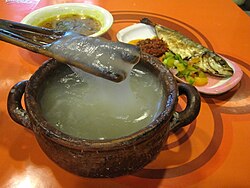
Porridge is a dish made by boiling ground, crushed, or chopped starchy plants (typically grains) in water, milk, [1] or both, with optional flavorings, and is usually served hot in a bowl or dish. It may be served as a sweet or savory dish, depending on the flavourings.































